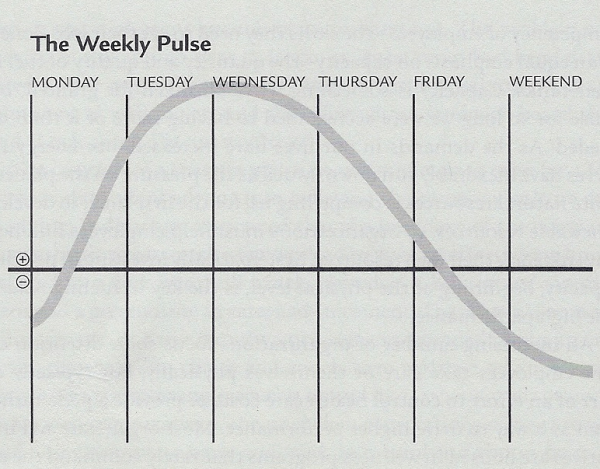If you’re an athlete or have watched sporting events you know that it’s recommended to stretch and jog before engaging in strenuous activity. Does it make sense that you should train your people to do the same thing in your work environment?
McGill University researcher Debbie Moskowitz believes you should, according to Be Excellent at Anything author Tony Schwartz. The chart in this blog reflects the patterns of energy the vast majority typically experience over the course of
a week. Just as athletes train in cycles-alternating intense work with periods of recovery daily, weekly, yearly-in an effort to marshal the highest energy for key competitive events, Schwartz believes leaders and their companies need to think in similar terms.

Taking directly from the book, Be Excellent at Anything, Moskowitz found that Monday is the best day for low-demand administrative tasks, including setting goals, organizing, and planning. By Tuesday, most of us are fully ramped up. Over the next two days, our capacity for focus and engagement is at a peak. It makes sense, both individually and organizationally, to tackle the most challenging work on those days. That means addressing the most difficult problems, taking on writing assignments, working through strategy, and doing creative brainstorming. By Thursday afternoon, Moskowitz has found, our energy often begins to ebb. This can be a good day for meetings in which reaching consensus is important. By Friday, we're usually at the lowest level of
energy for the week, especially in the afternoon. This can be a good day for more open-ended work, such as brainstorming, long-range planning, and relationship building. Designing the work flow for yourself and your team with these rhythms in mind means you're taking advantage of the natural flow of your energy and theirs.
The greater the demand the greater the need for regular renewal. Several companies including Sony have recognized this and have begun to adapt these principles. Andy Benson, Sony UK’s commercial director states, “The results were incredible, not only do people come through in better shape our dealer partners also noticed a sharper and more focused Sony.” Sony developed a Survival Guide for their people for its key dealers meetings each January, which follows their busiest season of fall heading into Christmas. For nearly a month their people are required to work long hours sharing marketing plans, negotiating contracts and socializing with dealer partners often staying even into the morning hours to complete their work and engagements with dealers. The meetings take a dreadful tool on their people and their families. Not only because they were away from their families but also because it takes time to recover once they get home.
The Survival Guide encouraged managers to focus on reducing alcohol intake during these evening meetings, ritualize morning exercise, eat more often and lightly and go to sleep at a designated and reasonable hour.
I encourage you to read Be Excellent at Anything to understand how your role as the leader of your organization sets the tone for growth and developing better habits that encourage greater productivity.
The unspoken expectations in most companies is arrive early and work late, hunker down in front of your computer, take as few breaks as possible, eat lunch at your desk; refuel energy between meals with caffeine and sugary snacks and then take work home in the evening and on the weekends. If that’s the type of environment you are cultivating you absolutely need to read this book and recognize the toll it’s taking on you and your team. It’s the death knell for your business and it will not provide sustainable performance for the long run, unless you are willing to replace and find a stead stream of new employees, say nothing of finding your own replacement if you don’t expire first.
Are you already aware of this weekly pulse with yourself and your people? Do you see any problem with adapting this to your business? What are your concerns in viewing this weekly pulse pattern? Are you afraid by observing this pattern your company may give your people permission to take it easy when they could be more productive?






.jpeg?width=150&height=135&name=Hand%20with%20marker%20writing%20the%20question%20Whats%20Next_%20(1).jpeg)

